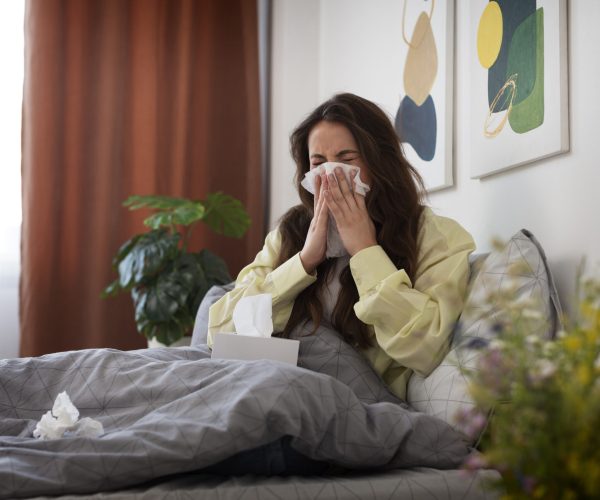5 Reasons for Indoor Allergies & Home Allergy Cures
Many people experience indoor allergies without realizing that their home environment may be contributing to their symptoms. Dust, pet dander, mold, and poor air circulation can trigger sneezing, coughing, itchy eyes, and even respiratory issues. If you’re looking for home allergy cures, one of the most effective steps is improving indoor air quality.

1. Dirty Air Ducts & Vents
Your HVAC system circulates air throughout your home, and if your air ducts and vents are dirty, they distribute dust, pollen, and allergens into every room. Clogged vents can worsen indoor allergies, making symptoms more severe.
How Dirty Air Ducts Trigger Allergies:
- Dust and debris accumulate in ductwork and get blown into living areas.
- Mold and bacteria grow in damp HVAC vents, releasing spores into the air.
- Pet dander and pollen settle inside air vents and get recirculated.

- Schedule professional air duct cleaning to remove allergens from your ventilation system.
- Use HEPA air filters in your HVAC system to trap fine particles.
- Vacuum vents and registers weekly to prevent dust buildup.
2. Mold & Mildew Growth
Mold thrives in humid environments, and when it spreads through air vents, bathrooms, basements, or crawl spaces, it releases spores that trigger allergic reactions. Mold exposure can cause respiratory issues, sinus infections, and worsen asthma symptoms.
Where Mold Grows in the Home:
- Inside air vents and ducts due to condensation buildup.
- Bathrooms, kitchens, and basements, where moisture levels are high.
- Carpets, upholstery, and insulation, which can trap mold spores.

- Use dehumidifiers to keep indoor humidity below 50%.
- Fix leaks and improve ventilation in high-moisture areas.
- Get professional air duct cleaning to remove mold from HVAC systems.
3. Dust & Dust Mites
Dust and dust mites are some of the most common indoor allergens. These tiny creatures thrive in carpets, bedding, upholstery, and air ducts, feeding on dead skin cells and producing waste that triggers allergic reactions.
How Dust Mites Affect Indoor Allergies:
- Their waste particles become airborne and cause sneezing, congestion, and itchy eyes.
- Dust accumulates inside HVAC vents, spreading allergens throughout your home.
- Soft furnishings and bedding trap dust mites and their allergens.

- Wash bedding in hot water weekly to kill dust mites.
- Use air purifiers with HEPA filters to trap airborne dust.
- Schedule routine HVAC vent cleaning to remove dust from air circulation.
4. Pet Dander & Hair
Even if you don’t own pets, pet dander from previous homeowners or visitors can linger in air vents, carpets, and upholstery. Pet hair and skin flakes become airborne, triggering itchy eyes, runny nose, and asthma symptoms in allergy sufferers.
How Pet Dander Affects Indoor Air Quality:
- Tiny dander particles stay suspended in the air for long periods.
- HVAC vents collect pet allergens, recirculating them through your home.
- Carpets, furniture, and bedding trap pet hair and allergens.

- Vacuum with a HEPA-filtered vacuum cleaner to remove pet hair and dander.
- Clean air vents and ducts to eliminate hidden allergens.
- Use anti-allergen bedding and furniture covers to prevent dander buildup.
5. Pollen & Outdoor Pollutants Entering the Home
Pollen can enter your home through open windows, HVAC vents, clothing, and shoes, causing seasonal allergies even when indoors. Outdoor pollutants like smoke, car exhaust, and industrial particles can also contribute to poor indoor air quality.
How Pollen & Outdoor Allergens Get Inside:
- HVAC systems pull in unfiltered outdoor air, introducing pollen.
- Clothing, shoes, and pets track in pollen and pollutants from outside.
- Open windows and doors allow allergens to settle indoors.

- Change HVAC filters regularly to block outdoor allergens.
- Wipe down pets, shoes, and clothes after coming inside.
- Keep windows closed during high pollen seasons and use an air purifier.
How Air Duct Cleaning Can Help Reduce Indoor Allergies
Even with regular cleaning, allergens accumulate inside air vents and ducts, creating continuous exposure for allergy sufferers. Professional air duct cleaning removes dust, mold spores, pet dander, and pollutants, leading to:




At Prime Clean Air, we provide expert air duct and vent cleaning services to help eliminate indoor allergens at their source.
Schedule Your Air Duct Cleaning Today
If you or your family suffer from indoor allergies, scheduling a professional HVAC duct cleaning can significantly improve air quality in your home.

Get in touch today
Want to know more about our services or need expert consultation? Just fill out the form below and one of our experienced team members will get back to you promptly.
